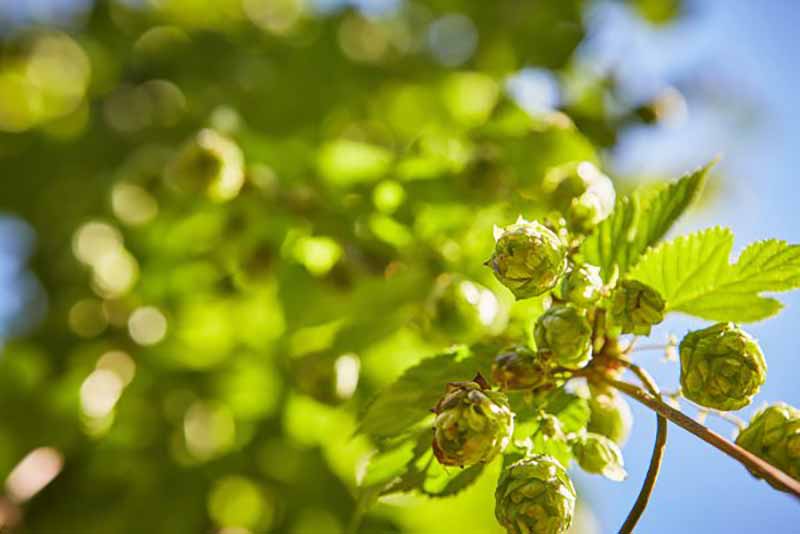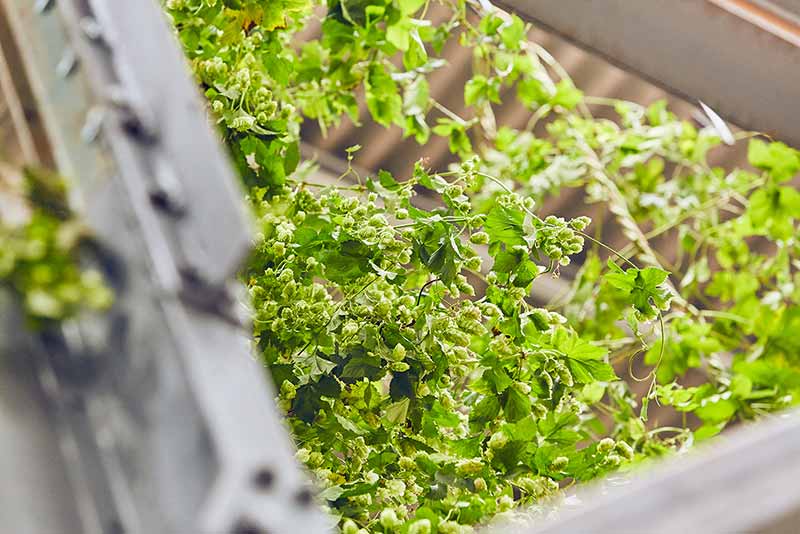
Every hop goes through a rigorous yearslong process to determine whether it’s viable to commercialize. We’ve covered many of the hops that broke through due to their unique qualities—Citra, Mosaic, Nectaron, and Galaxy, to name a few. Sometimes, though, a hop gains so much traction while it’s still in the “hop breeding” phase during soft commercialization of the product it’s worth a deeper dive—such as Krush (formerly known as HBC 586).
We chatted with several folks at John I. Haas as well as early adopters of the experimental hop, Odell Brewing and Columbus Brewing, to learn more about the ancestry and analytics, what characteristics make it shine, how to use it in the brewing process, and just when it might get a name.
(Above photography courtesy of Yakima Chief Hops)
Affordable, Industry-Leading Brewery Software
What Are the Ancestry and Analytics of Krush?

Graphic courtesy of John I. Haas
John I. Haas Director of Hop Breeding Michael Ferguson explains that the pedigree of Krush dates back to 2006—nine years before he arrived at the company in 2015.
“It was some numbered selection, not related to anything notable other than breeding selection in the program,” Ferguson says. “When I came on, it was a thirty-hill plot.”
According to the Krush page, the experiment crossed a hybrid pollination of an unpatented female selection YCR 21 and male parent 01239-2.
Ferguson says there was some interest in the hop, but when he got on, he passed it to John I. Haas Innovations Brewery Brewmaster and Director of Brewing Virgil McDonald to do some test runs.
“I came on and gave [Krush] to Virgil, and his team brewed it internally, and we thought it was fantastic,” Ferguson says, adding that the hop really gained traction in 2017. “After brewing and enjoying it, the next step is showing it to brewers at harvest. Virgil’s team put a [single-hop Krush] beer on tap for customers to taste. Odell was the first to taste it, and they contracted for the hop in 2017. A year later, Columbus Brewing sponsored it.”
As for analytics, Krush hops are high alpha, anywhere between 12-13%, and beta acids of around 7.5-8.5%. The oils are around 1.2-2.5 ml per one hundred grams.
“This last crop year, 2023, was a great year for the HBC 586 [now Krush] crop,” Ferguson says, “compared to previous years due to weather and wildfires.”
What Characteristics Are Most Prominent in Krush Hops?

Graphic courtesy of John I. Haas
Odell Technical Director Eli Kolodny says he gets a smorgasbord of aroma and flavor from Krush.
“We get a lot of ripe stone fruit, like mango and peach. I also get red fruit. Some berry,” Kolodny says. “That’s what initially drew us to it. It’s like a fruit punch when you combine the two.”
John I. Haas Sensory Manager Jeff Dailey says Krush is very complex.
“It has distinct tropical fruit character, like pineapple, mango, and Concord grape,” he says. “It has a biting character in a good way. There are notes of passion fruit, fresh-cut jalapeno or serrano, and citrus.”
Dailey adds that Krush is transparent in that it smells the same in the field as in a glass.
Columbus Brewing Director of Innovation Tony Corder said Krush checked off many boxes for the company, which brews a good amount of IPAs.
“For us, what drew us to it, to begin with, was we got similar aromatics of mango primarily, and then a tropical stone fruit combination,” Corder says. “But it had a dank edge to it. It struck a lot of chords for us. We always like to work with stuff that can work with many different beers— especially American IPA, and the dankness helps. But the hop leads with mango.”
Where in the Brewing Process Should You Use Krush Hops?
Corder says they tend to use it more on the cold side.
“Certainly in the dry hop,” he says. “We’ll use it in the whirlpool. You can use it throughout, but it’s most impactful on the dry hop. I would say anywhere in the dry hop. Primarily, the bulk of our dry hops are late stage, but it’s certainly worth a shot to try it earlier.”
Kolodny says Odell works in their Krush similarly to Columbus.
“We use it all over. Primarily though, we hit it in the dry hop—typically a little late in the dry hop program,” he says. “We do have quite a few on the hot side, but the majority are in the dry hops.”
Dailey says you could use it for bittering, but that would be somewhat of a waste.
“You can use any hop as a bitter hop, but not every hop as a flavor hop,” Dailey says. “I wouldn’t waste it as a bittering hop unless I was just given the hops for free.”
McDonald says to definitely use it in the dry hop or the whirlpool.
“The further you get upstream, it changes the character,” McDonald says.
Dailey adds, “It works throughout the dry hop, not just late or terminal. It creates great flavor.”
Dailey compared the hop to Citra, because it can work well independently but pairs well with others.
“On its own, it really slaps,” Dailey says.
What Is the Dosing Rate for Krush Hops?

Photography courtesy of Yakima Chief Hops
McDonald says there comes a point when the Krush hop reaches a point where it fades off significantly.
“We like about two pounds per barrel,” McDonald says. “Over two to three pounds per barrel dry hop can get rubbery.”
Corder says he can’t definitively know the saturation point of the hop, but he says they haven’t approached a point where it’s been too much as of yet.
“We have full confidence in brewing a single-hop IPA with it,” Corder says. “So that usage rate is obviously multiple pounds per barrel when you include the dry hop.”
Kolodny was matter-of-fact in his reply on how much Krush to use.
“Under a pound per barrel,” he says.
Which Styles of Beer Work Best for Krush Hops?
McDonald says he could see it working well in a lighter lager if you use the hop sparingly. But he likes the hop in a pale ale “because you aren’t fighting the malt backbone.”
“It can be used with anything,” McDonald says. “The market is IPA-centric, so that’s what we see it in. … I can see HBC 586 [now Krush] playing with about anything.”
Dailey says he would love to see the hop used in an American wheat.
“Brewers shouldn’t be afraid to try it in new things,” he says.
McDonald adds that the hop is pretty forgiving.
“The hop hasn’t had harsh flavors or given sass back,” McDonald says.
Corder says they’ve used it in a hazy IPA, but primarily American IPA, double IPAs, and pale ales.
“I think 586 is very versatile. It could be a good partner. It can bring out some complexity,” Corder says. “It could be the lead or be the supporter. It could be a single hop or lean heavily on it, and it can carry that heavy lift.”
Odell has been using the hop in their Good Behavior session IPA, which is around 4% ABV. They have also used it in a hazy IPA “and used the hop with reckless abandon,” Kolodny says. “We feel where it works really well is in lower-alcohol beer.”



